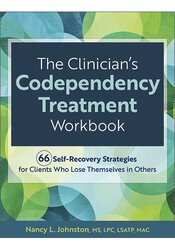Demystifying Codependency: A Comprehensive Guide for Clinicians

When you hear the word ãcodependency,ã are you not quite sure what to say or do with it? Does it stir mixed emotions within you that draw you both towards and away from the word. Does its meaning illude you, bother you, invoke your curiosity, clarify your clinical workãor perhaps all of these reactions? Well, you are not alone.
Codependency is a relational way of being that was identified over 40 years ago in the field of alcoholism treatment. The word has been overused and ignored, disparaged and respected. Despite this range of responses to it, the intra/interpersonal dynamics of codependency are real and merit our attention in our clinical work as those dynamics often contribute to the anxiety, depression, and relationship problems clients come to therapy for.
Codependency can be clinically illusive for several understandable reasons:
Guided by research findings, here are core features of codependency:
In this , youãll see a a few of my self-recovery strategies for clients who lose themselves in others.
Codependency is a relational way of being that was identified over 40 years ago in the field of alcoholism treatment. The word has been overused and ignored, disparaged and respected. Despite this range of responses to it, the intra/interpersonal dynamics of codependency are real and merit our attention in our clinical work as those dynamics often contribute to the anxiety, depression, and relationship problems clients come to therapy for.
Codependency can be clinically illusive for several understandable reasons:
- Our fields of mental health and addictions have not yet established an agreed-upon definition for codependency. The topic has lived in the self-help worldsãwhich has been beneficial for many, thankfully. But knowing what it looks like in our office and what to do with it if we think it is a clinical factor has not been developed thoroughly.
- Codependency can have a negative connotation, and we donãt want to blame or pathologize our client for their often thoughtful, giving way of being. So, we avoid it rather than absorbing that codependent behaviors are both natural and adaptive and can be viewed objectively on a continuum from perfectly okay to obsessive.
- Codependency often presents as likeable, understandable, and can feel appealing to the clinician as the client leans toward them as the expert they seek to please.
Guided by research findings, here are core features of codependency:
- Strong external focus. This means that rather than having a balanced focus on their external and internal experiences, the person is consistently focused outside of self. They are watching for what others are thinking, doing, or needing. Their value is determined by their value to others. Their emotions are dependent on the emotions of others. Their sense of self is dependent on things outside self.
- Dominantly other-centered. Clearly this is an extension of a strong external focus, but it merits its own description. We are familiar with self-centeredness. Other-centeredness falls at the other end of the continuum of self and other. An other-centered person has difficulty bringing the focus to self. They may talk a lot about the problems of others, seek to find solutions to those problems, and/or organize their life around the needs and desires of others. The clinical goal is to help the client increase their ability to focus on self so they can operate within the middle range of consideration of self and other.
- Overfunctioning for others/underfunctioning for self. The imbalance in self and others described above can naturally pour into this dynamic. Overfunctioning for others can include doing for the other person what they can do for self, thinking for them, speaking for them, or acting on their behalf without their inclusion or permission. Underfunctioning for self can include your client not taking care of their own needs, not factoring in self when making decisions, and offering more time and money than they have to give.
- Loss of self in others. This is the ultimate extension of these features of codependency. Loss of selfãself being eclipsed in relationship with othersãleads to the symptoms we are most familiar with: anxiety, depression, and chronic relationship problems. Loss of self feels terrible, can be desperate, and leaves the person stuckãnot knowing where to go, what to do, or that what they seek can be found within.
In this , youãll see a a few of my self-recovery strategies for clients who lose themselves in others.
Book:
The Clinicianãs Codependency Treatment Workbook
The Clinicianãs Codependency Treatment Workbook

Maybe your client is a chronic people-pleaser who canãt seem to say no, a parent who continues to rescue their adult child from the consequences of their addiction, a survivor of abuse who minimizes and numbs their emotional pain, or someone who simply has no idea who they are or what they want because theyãve spent their entire life anticipating and catering to the needs of others.
Although codependencyãor loss of self in othersãis rooted in addictions work, it is a complex and often overlooked dynamic that underlies many of the issues that bring clients to therapy, including anxiety, depression, trauma, substance use, eating disorders, and more. In The Clinicianãs Codependency Treatment Workbook, youãll learn how to identify telltale symptoms of this relational dynamic and help clients restore their connection to who they truly are.
Although codependencyãor loss of self in othersãis rooted in addictions work, it is a complex and often overlooked dynamic that underlies many of the issues that bring clients to therapy, including anxiety, depression, trauma, substance use, eating disorders, and more. In The Clinicianãs Codependency Treatment Workbook, youãll learn how to identify telltale symptoms of this relational dynamic and help clients restore their connection to who they truly are.
Online Course:
Codependency Treatment Certificate Course
Codependency Treatment Certificate Course

Elevate your expertise with this comprehensive program designed to equip therapists with the tools, strategies, and insights to effectively guide clients towards freedom from codependency and reclaiming their authentic selves. Led by seasoned practitioners, you'll gain the skill to empower clients on their journey to healing and self-discovery.
Meet the Expert:
Nancy Johnston, LPC, LSATP, MAC, NCC, has been a therapist for over 40 years and is an expert in the field of codependent relationships. The author of Disentangle: When Youãve Lost Your Self in Someone Else (2020), Nancy has helped thousands of clients extricate themselves from toxic codependency, connect with self, and live with more peace and confidence.
Learn more about her educational products, including upcoming live seminars, by clicking here.
Learn more about her educational products, including upcoming live seminars, by clicking here.



